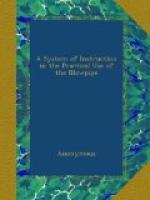Sesquioxide of antimony melts easily, and sublimes as a white vapor. It may be prepared by precipitating and drying. When heated, it takes fire previous to melting, glows like tinder, and is converted into antimonious acid, which is now infusible. When heated upon charcoal in the flame of reduction, it is reduced to the metallic state, and partly volatilized. A white vapor sublimates upon the charcoal, while the external flame exhibits a greenish-blue color. Antimonious acid is infusible, produces a strong light, and is diminished in volume when heated in the external flame, during which time a dense white vapor sublimes upon the charcoal. It is not, however, in this manner reduced to the metallic state like the sesquioxide.
Antimonic acid, when first heated, becomes white, and is converted into antimonious acid. Hydrated antimonic acid, which is originally white, appears at first yellow while giving off water, and then becomes white again, while oxygen is expelled, and it is converted into antimonious acid.
The oxides of antimony produce, with blowpipe reagents, the following reactions: borax dissolves oxides of antimony in the oxidation flame in considerable quantity to a clear bead, which is yellow while hot, but colorless when cold. If the bead is saturated, a part of the oxide is volatilized as a white vapor. Upon charcoal, in the oxidation flame, it is completely volatilized, and the charcoal is covered with a white sublimate. Heated upon charcoal in the reducing flame, the bead is of a greyish color, and partially, if not wholly opaque, from the presence of reduced metallic particles. A continued heat will volatilize them, and the bead becomes clear. The addition of tin promotes the reduction.
Microcosmic salt dissolves the compounds of antimony in the flame of oxidation with intumescence, to a clear light-yellow colored bead, which when cold is colorless. Heated upon charcoal in the reduction flame, the bead is first turbid, but soon becomes transparent. The addition of tin renders the bead greyish while cooling, but a continued blast renders it transparent. Soda dissolves the compounds of antimony upon platinum wire in the oxidation flame, to a clear colorless bead, which is white when cold.
Upon charcoal, both in the oxidation and reduction flames, the antimony compounds are readily reduced to the metal, which is immediately volatilized, and produces a white incrustation of oxide of antimony upon the charcoal. If the antimony compounds are heated upon charcoal in the flame of reduction, with a mixture of carbonate of soda and cyanide of potassium (KCy), there are produced small globules of metallic antimony. At the same time, a part of the reduced metal is volatilized (this continues after the assay is removed from the flame) and re-oxidized. A white incrustation appears upon the charcoal, and the metallic globules are covered with small white crystals. If this white sublimate upon the charcoal is moistened with a solution of cobalt-oxide, and exposed to the reduction flame, a part of it is volatilized, while the other part passes into higher oxidation, and remains, after cooling, of a dirty dark-green color.




